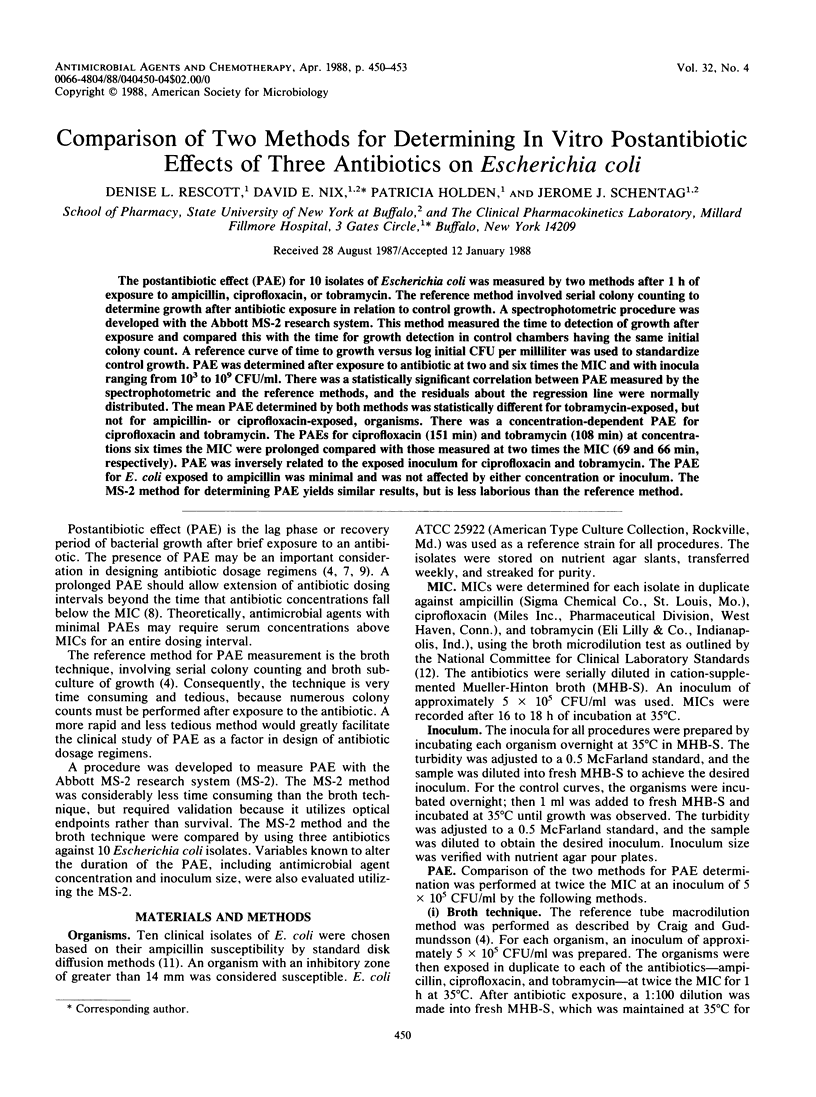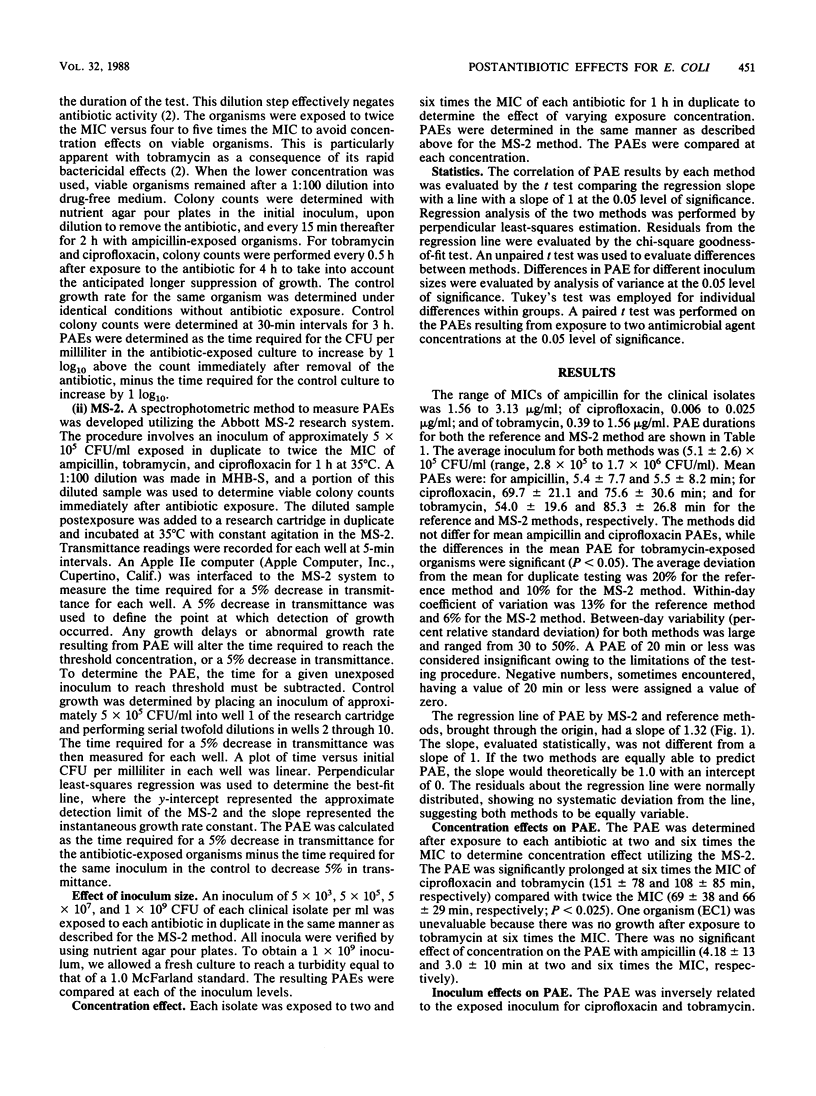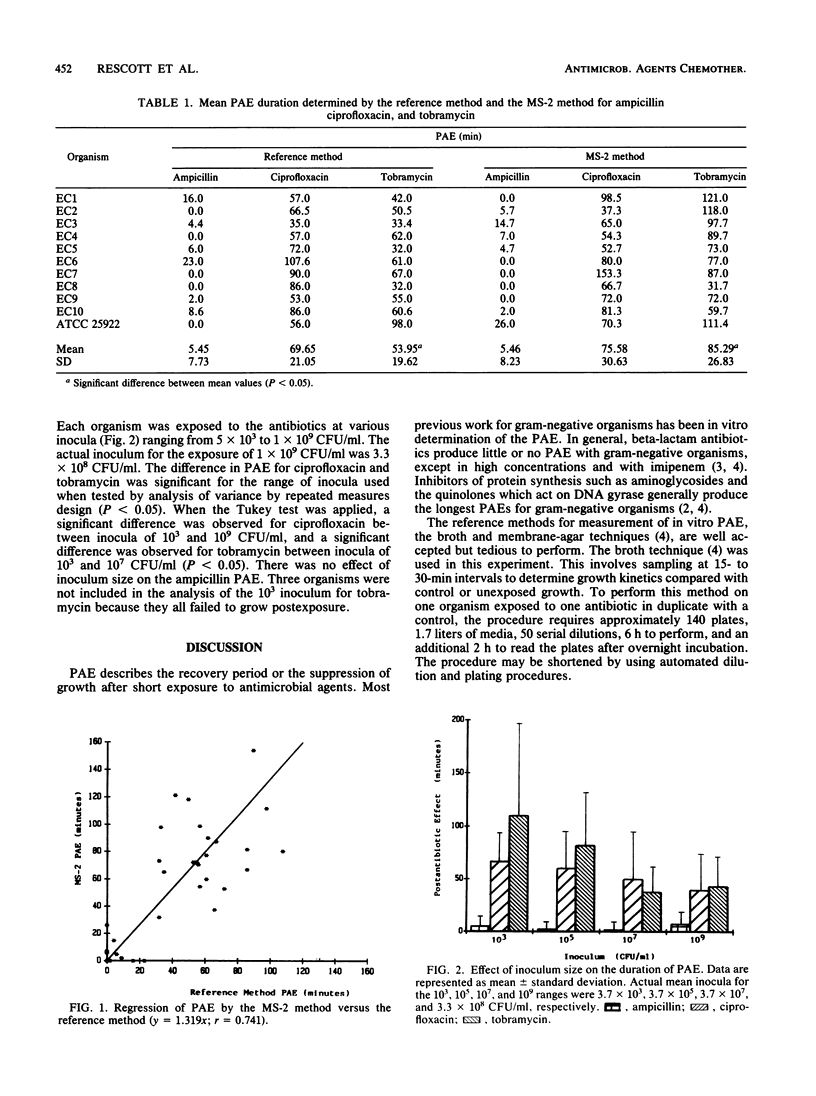Abstract
The postantibiotic effect (PAE) for 10 isolates of Escherichia coli was measured by two methods after 1 h of exposure to ampicillin, ciprofloxacin, or tobramycin. The reference method involved serial colony counting to determine growth after antibiotic exposure in relation to control growth. A spectrophotometric procedure was developed with the Abbott MS-2 research system. This method measured the time to detection of growth after exposure and compared this with the time for growth detection in control chambers having the same initial colony count. A reference curve of time to growth versus log initial CFU per milliliter was used to standardize control growth. PAE was determined after exposure to antibiotic at two and six times the MIC and with inocula ranging from 10(3) to 10(9) CFU/ml. There was a statistically significant correlation between PAE measured by the spectrophotometric and the reference methods, and the residuals about the regression line were normally distributed. The mean PAE determined by both methods was statistically different for tobramycin-exposed, but not for ampicillin- or ciprofloxacin-exposed, organisms. There was a concentration-dependent PAE for ciprofloxacin and tobramycin. The PAEs for ciprofloxacin (151 min) and tobramycin (108 min) at concentrations six times the MIC were prolonged compared with those measured at two times the MIC (69 and 66 min, respectively). PAE was inversely related to the exposed inoculum for ciprofloxacin and tobramycin. The PAE for E. coli exposed to ampicillin was minimal and was not affected by either concentration or inoculum. The MS-2 method for determining PAE yields similar results, but is less laborious than the reference method.
Full text
PDF



Selected References
These references are in PubMed. This may not be the complete list of references from this article.
- Bundtzen R. W., Gerber A. U., Cohn D. L., Craig W. A. Postantibiotic suppression of bacterial growth. Rev Infect Dis. 1981 Jan-Feb;3(1):28–37. doi: 10.1093/clinids/3.1.28. [DOI] [PubMed] [Google Scholar]
- Bustamante C. I., Drusano G. L., Tatem B. A., Standiford H. C. Postantibiotic effect of imipenem on Pseudomonas aeruginosa. Antimicrob Agents Chemother. 1984 Nov;26(5):678–682. doi: 10.1128/aac.26.5.678. [DOI] [PMC free article] [PubMed] [Google Scholar]
- Eagle H., Musselman A. D. THE SLOW RECOVERY OF BACTERIA FROM THE TOXIC EFFECTS OF PENICILLIN. J Bacteriol. 1949 Oct;58(4):475–490. doi: 10.1128/jb.58.4.475-490.1949. [DOI] [PMC free article] [PubMed] [Google Scholar]
- Eagle H. THE RECOVERY OF BACTERIA FROM THE TOXIC EFFECTS OF PENICILLIN. J Clin Invest. 1949 Sep;28(5 Pt 1):832–836. doi: 10.1172/JCI102161. [DOI] [PMC free article] [PubMed] [Google Scholar]
- Gengo F. M., Mannion T. W., Nightingale C. H., Schentag J. J. Integration of pharmacokinetics and pharmacodynamics of methicillin in curative treatment of experimental endocarditis. J Antimicrob Chemother. 1984 Dec;14(6):619–631. doi: 10.1093/jac/14.6.619. [DOI] [PubMed] [Google Scholar]
- Gerber A. U., Wiprächtiger P., Stettler-Spichiger U., Lebek G. Constant infusions vs. intermittent doses of gentamicin against Pseudomonas aeruginosa in vitro. J Infect Dis. 1982 Apr;145(4):554–560. doi: 10.1093/infdis/145.4.554. [DOI] [PubMed] [Google Scholar]
- McCormack J. P., Schentag J. J. Potential impact of quantitative susceptibility tests on the design of aminoglycoside dosing regimens. Drug Intell Clin Pharm. 1987 Feb;21(2):187–192. [PubMed] [Google Scholar]
- McDonald P. J., Craig W. A., Kunin C. M. Persistent effect of antibiotics on Staphylococcus aureus after exposure for limited periods of time. J Infect Dis. 1977 Feb;135(2):217–223. doi: 10.1093/infdis/135.2.217. [DOI] [PubMed] [Google Scholar]
- Ravizzola G., Caruso A., Manca N., Savoldi E., Turano A. In-vitro activity of cefotetan and other cephalosporins on Klebsiella and resistance to inactivating bacterial enzymes. J Antimicrob Chemother. 1983 Jan;11 (Suppl):133–138. doi: 10.1093/jac/11.suppl_a.133. [DOI] [PubMed] [Google Scholar]
- Shah P. M. Bactericidal activity of ampicillin and amoxicillin. J Antimicrob Chemother. 1981 Nov;8 (Suppl 100):93–99. doi: 10.1093/jac/8.suppl_c.93. [DOI] [PubMed] [Google Scholar]


